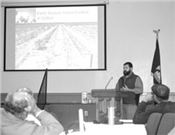|
Mild Winter Could Result In Pest Problems For 2020 Growing Season

LSU AgCenter entomologist Sebe Brown speaks to farmers about managing insects on their crops at the AgCenter
Northeast Louisiana Crops Forum held Feb. 6 in Delhi, Louisiana.
Photo by Karol Osborne/LSU AgCenter
DELHI, LA.
Amid concerns the 2020 growing season is setting up for a repeat of last year’s challenges, LSU AgCenter experts emphasized early-season management strategies at the Northeast Louisiana Crops Forum held Feb. 6 in Delhi.
“This meeting is important and timely because it provides updates on crop production and protection as growers are beginning to make those critical planting decisions now,” said AgCenter associate vice president Rogers Leonard.
Continued warm, wet weather conditions in the region, worsened by the lack of cooler temperatures this winter, increases the potential for tough weed and insect management situations moving forward, he said.
“We haven’t been cold enough so prepare for red-banded stinkbugs if you are growing soybeans,” AgCenter entomologist Sebe Brown said.
Louisiana has experienced the second year in a row with no real winter, and Brown predicts large populations of redbanded stink bugs and other species of plant bugs overwintering and finding plenty of alternative host plants in the fields on which to feed.
Brown urged growers to use high-quality seed treatments in all agronomic crops to boost yield and preserve quality.
“Over time, these insecticides do pay for themselves and are a good investment,” he said.
In on-station trials designed to mimic worst-case scenarios faced by producers, increased yields are common when seed treatments are used, Brown said.
A new technology in Deltapine cotton could potentially eliminate the need for a seed treatment against thrips once it becomes available in the next few years, he said.
“Thrips are the No. 1 early-season pest issue in Louisiana for cotton, and where this product excels is in thrips control,” he said.
While no silver bullet, the new cotton variety called ThryvOn will offer good activity on plant bugs and help by cutting down the number of insecticide applications needed through the growing season, he said.
Brown said a robust ear protection for corn earworms is not needed in the Midsouth citing the importance of protecting cotton production.
“It is a recipe for disaster,” he said.
Brown said 95 percent of corn earworms will funnel through corn first before moving into cotton, and using the same viptera genetic traits in both crops increases exposure of corn earworms to the technology.
AgCenter weed scientist Donnie Miller said planning burndown timing at four to six weeks before planting is optimum to allow time for weeds to die, reduce weed regrowth and remove food sources from overwintering insect pests that can move in and damage emerging crops.
Miller recommended producers add a residual mode of action herbicide for burndown at six weeks or more from planting to prevent weed emergence, provided 30% or less ground cover from winter weeds exists in the field for maximum results.
For growers able to get in the field for early-stage corn planting in late February to mid-March, yield can be maximized with only one postemergence herbicide application beginning at V2 or V4 growth stage, he said.
“When we start delaying things, and with higher soil temperatures signaling earlier weed emergence to compete with the emerging crop, you’ll have to have both pre- and post-applications out there,” Miller said.
Miller urged growers to always include a residual herbicide in each application, including burndown, to increase long-range effectiveness and aid in weed resistance mitigation, regardless of what weed management technology is used.
“Never let your opponent get off the mat – that’s what we want to do with these resistant weeds,” he said.
AgCenter Northeast Region director Melissa Cater encouraged producers to attend an upcoming soil health workshop and cover crop field day as part of the Patrick F. Taylor Foundation project to be held Feb. 26 at the AgCenter Northeast Research Station in St. Joseph.
“The Taylor project is a large effort by the AgCenter to demonstrate best management practices in production on commercial-size farms showing that those operations can be both productive and profitable as well as environmentally sustainable,” said AgCenter associate vice president Michael Salassi.
“We are working to identify essential production needs and developing research and extension projects to address those needs, Salassi said. Funding from key commodity boards, such as the Louisiana Cotton and Grain Association, the Louisiana Soybean and Grain Research and Promotion Board and the Louisiana Rice Research and Promotion Board are vital in achieving that mission.
The AgCenter is expanding research, extension and education efforts in precision agriculture and has updated weather data from seven stations across the state where real-time weather data, charts and reports can be accessed, Salassi said. The link to the website is: http://weather.lsuagcenter.com/ .
Other presentations included:
• Fertilizer recommendation philosophies by AgCenter soil fertility specialist Rasel Parvej.
• Plant pathology update by AgCenter plant pathologist Trey Price.
• Corn and cotton update by AgCenter corn and cotton specialist Dan Fromme.
• Soybean update by AgCenter plant pathologist Boyd Padgett.
• Worker Protection Standard and record keeping by AgCenter extension agent Carol Pinnell-Alison.
• Product-specific training by AgCenter extension agent Bruce Garner. ∆
|
|